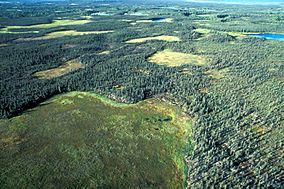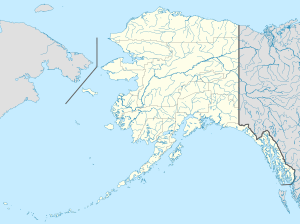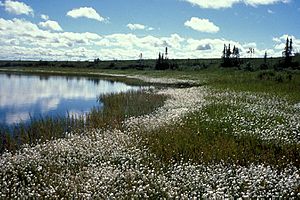Selawik National Wildlife Refuge facts for kids
Quick facts for kids Selawik National Wildlife Refuge |
|
|---|---|
|
IUCN Category IV (Habitat/Species Management Area)
|
|

Selawik Refuge Wetlands
|
|
| Location | Alaska, United States |
| Nearest city | Selawik, Alaska |
| Area | 3,400 sq mi (8,800 km2) |
| Established | 1980 |
| Governing body | U.S. Fish and Wildlife Service |
| Website | Selawik NWR |
The Selawik National Wildlife Refuge is a huge protected area in northwest Alaska. It was officially created in 1980 by a law called the Alaska National Interest Lands Conservation Act (ANILCA). This law helps protect special natural places in Alaska.
This national wildlife refuge is a safe home for many animals. You can find mammals like muskoxen, wolverines, grizzly bears, moose, and black bears. There are also two types of fox, beavers, caribou, martens, river otters, Canadian lynx, porcupines, mink, and even wolf packs. Many birds live here too, such as snow geese, tundra swans, and Canada geese.
The refuge is very large, covering about 3,400 square miles (8,700 square kilometers). It sits right on the Arctic Circle, which is an imaginary line around the Earth. The refuge is east of Kotzebue Sound. To the north, it is bordered by the Waring Mountains and Kobuk Valley National Park. To the south, you'll find the Selawik Hills and the Purcell Mountains. The refuge stretches east towards the beginning of the Selawik River and the Continental Divide. The people who manage the refuge work from offices in Kotzebue.
What the Land Looks Like
The Selawik Refuge has many different types of land. Some areas are alpine tundra, which means cold, treeless plains high up in the mountains. Other parts are arctic tundra, which is also cold and treeless but at lower elevations. You can also find taiga, which is a type of forest with mostly evergreen trees.
There are many lakes and wet areas, along with large river deltas. You'll see open fields of grass and sedge plants. Some mountains and river valleys in the refuge were shaped by glaciers a long time ago. There are also rolling sand dunes covered in plants. These dunes were formed when the last glaciers melted away. They are what's left of a much bigger sand system that included the Great Kobuk Sand Dunes to the north.
This area is a special "transition zone." It's where the northernmost boreal forests (forests of the cold northern regions) start to change into the open Arctic tundra. The deltas of the Selawik and Kobuk Rivers are located on the eastern shores of Selawik Lake and Hotham Inlet. These areas are very important for birds that migrate (travel long distances) each year.
The refuge has many different types of water bodies. There are freshwater lakes and brackish lakes (which are a mix of fresh and salt water). There are also areas along rivers and wet meadows. All these different habitats provide large, undisturbed places for many kinds of wildlife. The lowlands of the refuge have about 21,000 lakes, creating a huge complex of Arctic tundra lakes.
Selawik Wilderness Area
In 1980, at the same time the refuge was created, a part of it was also made into the Selawik Wilderness. This wilderness area covers 240,000 acres in the northern part of the refuge. It is part of the National Wilderness Preservation System.
A wilderness area is a place where nature is left completely wild and untouched by humans. There are no trails or buildings in the Selawik Wilderness. Because of this, it is very difficult to access this area. It's truly a wild and remote place.



